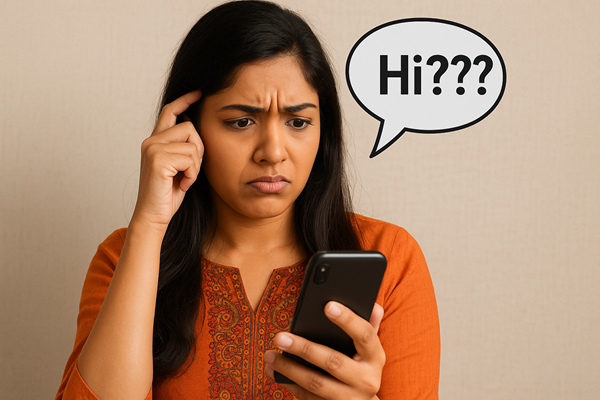.png)
The Art Of Saying Nothing: India’s “Hi” Culture
In a hyper-connected India, our digital hellos often reveal a deeper discomfort with clarity, confidence, and saying what we truly mean.


Dr. Srinath Sridharan is a Corporate Advisor & Independent Director on Corporate Boards. He is the author of ‘Family and Dhanda’.
May 24, 2025 at 5:38 AM IST
There’s a curious kind of message that lands in our phones these days. It doesn’t carry news or affection or urgency. It simply says, “hi.” One word. Lowercase. No punctuation. No follow-up. Just a digital pebble thrown into the quiet pond of your day.
You see it and pause. What is this about? Is something wrong? Did I miss something? You open the chat, stare at the solitary syllable, and then wait. Nothing comes. No explanation. No sentence. Not even a sticker. You’re left hanging in an awkward digital limbo, unsure if you should prompt them or just let the message float there like a lonely paper boat.
Those single-word “hi” messages, especially when dropped without context or follow-up, can be incredibly irritating. It’s like someone ringing your doorbell and walking away, expecting you to chase them down to ask what they wanted. It puts the onus on you to respond and engage, instead of the person just stating their purpose up front.
It’s not the message that irritates. It’s the complete lack of intent. We live in a time when everyone is managing more than they let on. Work pings. Family groups. Random memes. Emotional tightropes. Calendar clutter. Mental tabs left open. Amid all that, a one-word message that goes nowhere feels less like a greeting and more like a poke in the ribs.
We’ve all been there. A friend. A colleague. An old schoolmate you haven’t heard from in twelve years. Suddenly they pop up with “hi” and nothing more. As if your time is a buffet and they’re waiting to be served. You feel the weight of social expectation. You’re supposed to respond warmly. You’re supposed to prompt them. You’re supposed to say, “Yes, tell me.” But why?
We are a high-context society. We pride ourselves on relationships, formalities, and a certain conversational foreplay. In real life, we ask if someone has eaten before we ask about work. We comment on the weather before we discuss money. On WhatsApp, though, this habit seems to have evolved into a strange digital tap on the shoulder that refuses to explain itself.
This isn’t about being curt. It’s about being clear. It’s about being respectful of attention. Because increasingly, attention is a currency—and a scarce one at that. The “hi” message isn’t harmless. It is, in many cases, a speed bump. It slows down the flow of the day and leaves the burden of follow-up entirely on the recipient. It asks the other person to do the work. And let’s face it, that’s a little lazy.
It’s not just about efficiency. It’s about intent. When someone messages just “hi,” they aren’t starting a conversation. They’re outsourcing the effort of beginning one. We don’t knock on someone’s door and then step back in silence waiting for them to guess what we want. We say what we came to say. Why should it be different online?
This isn’t a generational thing. Gen Z, for all their brevity, tend to get to the point. The “hi” epidemic often stems from mid-level professionals—people caught between analog formality and digital immediacy. You see it on LinkedIn: a 47-year-old manager from a legacy company who sends “hi” and nothing else. Or a government officer’s assistant who opens with “hi,” disappears for three days, then follows up with “Sir wants to know if you can speak at an event tomorrow.”
Why not just say that upfront? Why the theatrical pause? Because somewhere in our cultural wiring, there’s a hesitation to be direct. We confuse clarity with rudeness. We mistake assertiveness for arrogance. We’ve been raised to believe that asking for what we want is somehow impolite, so we hedge, hint, and hope the other person fills in the blanks.
Some defend this as courtesy. “We’re not abrupt like the Americans,” a sociologist friend once told me. “We ease into conversations.” But is it really courtesy—or is it just evasion dressed up as etiquette?
For first-generation professionals especially, the lone “hi” can be a way of building courage. It’s a neutral, non-threatening opener in a language they may not fully own. And that deserves empathy. But even then, we need to evolve a vocabulary of access that builds bridges without putting the burden on the other side to decode meaning.
Because this isn’t just about WhatsApp. This kind of ambiguity is everywhere. In offices, in emails, in boardrooms. The refusal to say things clearly results in missed cues, delayed decisions, and endless “gentle reminders.” A clearly-worded message could solve the issue in two lines, but instead, we end up cc’ing five people and hoping one of them will say what needs to be said.
Digital etiquette is becoming as real as physical manners. Just as we were taught not to interrupt or mumble or hover awkwardly at someone’s desk, we now need to learn to communicate with purpose online. A simple “Hi, quick question about…” or “Hey, are you free for a minute?” shows clarity, respect, and intention. It reduces anxiety. It signals that we value the other person’s time.
Of course, sometimes a “hi” is just a warm nudge from someone who matters—a parent, a partner, a friend who doesn’t need to say more. You know the difference. The silence that follows feels familiar, not demanding. But in most work or semi-formal contexts, the lone “hi” is a conversation with its brakes on.
So maybe we need to change how we respond. Instead of immediately asking, “Yes?”, we could mirror the ambiguity. Reply with a “hello” and let it sit. Or just send back a waving emoji and move on. That might gently nudge the sender into developing more digital courage. Or at the very least, make them realise that adult conversations shouldn’t feel like a schoolyard note passed under the desk.
The world is moving fast. Power flows to those who can say what they mean and ask for what they need. Precision is not coldness. It’s kindness with clarity. And in a culture already fatigued by screens and scattered attention, it’s the least we can offer one another.
So the next time someone sends you “hi” and nothing else, smile politely—and carry on. You’re not being rude. You’re just conserving your conversational sanity.
Until then, brace yourself.
Your next great conversation may still begin with…
“Hi.”



